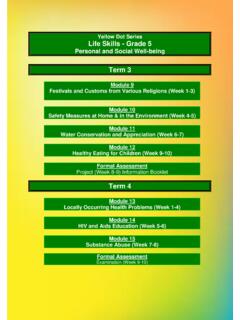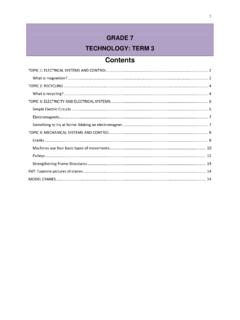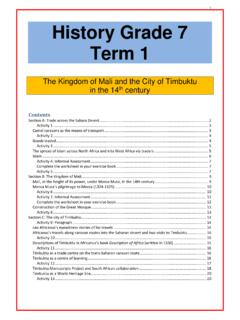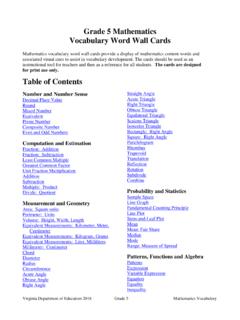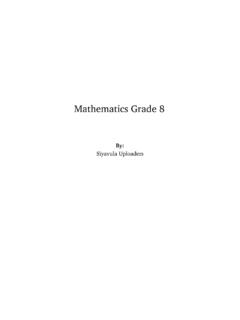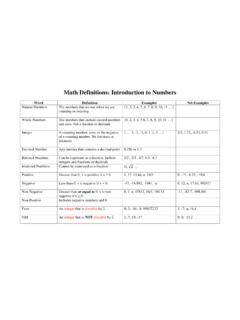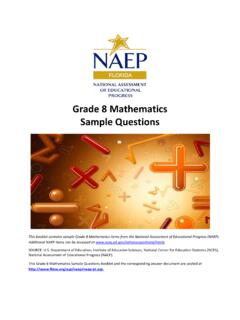Transcription of GRADE 7 MATHS TERM 1: WHOLE NUMBERS - Brackeham …
1 Page 1 of 49 GRADE 7 MATHS TERM 1: WHOLE NUMBERS WHOLE NUMBERS .. 5 CALCULATIONS WITH WHOLE NUMBERS .. 6 TERMINOLOGY .. 7 1. Ordering NUMBERS .. 7 2. Comparing NUMBERS .. 7 3. Round off NUMBERS to the nearest 5, 10, 100 or 1000 .. 7 4. Representing NUMBERS .. 7 5. Factors .. 7 6. Multiples .. 8 7. Prime NUMBERS .. 8 8. Composite NUMBERS .. 8 9. Inverse Operations .. 8 PROPERTIES OF WHOLE NUMBERS .. 8 10. Properties of NUMBERS .. 9 A. COMMUTATIVE PROPERTY .. 9 B. THE ASSOCIATIVE PROPERTY .. 10 C. DISTRIBUTIVE PROPERTY .. 10 11. When multiplying or dividing by multiples of 10, 100, 1000.
2 10 12. Identity element for addition .. 10 13. Identity element for multiplication .. 10 Exercise 1 .. 11 Exercise 2.. 12 DOING THE FOUR OPERATIONS A REMINDER: .. 13 VERTICAL METHOD .. 13 ADDITION .. 13 SUBTRACTION .. 13 MULTIPLICATION .. 14 DIVISION - (LONG DIVISION .. 14 Exercise 3 .. 14 Page 2 of 49 ADDITION HORIZONTAL METHOD .. 15 HORIZONTAL 15 Exercise 4 .. 15 FOLLOWING A SPECIFIC ORDER OF OPERATIONS .. 16 BODMAS .. 16 Exercise 5.. 17 MULTIPLES AND FACTORS .. 18 Highest Common Factor and Lowest Common Multiple .. 19 HCF Example .. 19 LCM Example.)
3 19 Finding HCF & LCM with prime factorizations .. 19 Exercise 6 .. 20 Find the Lowest Common Multiple (LCM) .. 21 Highest Common Factor (HCF) .. 22 EXPONENTS .. 23 Exponents .. 24 Exercise 1 .. 24 Square roots .. 24 Cube Root .. 25 Exercise 2 .. 25 Exercise 3 .. 26 Use prime factors to write NUMBERS in exponential form (Ladder method) .. 26 Exercise 4 .. 26 Use the exponential form to calculate square roots and cube roots .. 27 Exercise 5 .. 28 Calculations using NUMBERS in exponential form .. 28 Exercise 6 .. 29 NUMBERS in Exponential form .. 29 Exercise 7.
4 30 RATIO AND RATE .. 31 DEFINITIONS .. 31 Page 3 of 49 RATIO .. 31 31 EXERCISE 1 .. 31 EXERCISE 2 .. 32 Sharing a WHOLE in a given ratio .. 32 EXERCISE 3 .. 33 CALCULATING PERCENTAGE INCREASE AND DECREASE .. 33 EXERCISE 4 .. 33 CONCEPT : CALCULATING VAT, INTEREST AND DISCOUNT .. 34 GEOMETRY OF STRAIGHT LINES .. 36 CONCEPT : GEOMETRY (LINES AND ANGLES) .. 38 GEOMETRY CONCEPTS .. 38 1. Line .. 38 2. Line Segment .. 38 3. Ray .. 38 4. Parallel Lines .. 38 5. Perpendicular Lines .. 39 Vertical Lines .. 39 Horizontal Lines .. 39 Diagonal Lines .. 39 Exercise 1.
5 39 CLASSIFICATION OF ANGLES .. 41 WHAT IS AN ANGLE .. 41 CLASSIFICATION OF ANGLES ACCORDING TO MAGNITUDE .. 41 ACUTE 41 RIGHT 41 OBTUSE ANGLE .. 42 STRAIGHT ANGLE .. 42 REFLEX ANGLE .. 42 REVOLUTION .. 42 Exercise 2 .. 42 Page 4 of 49 Measuring and naming angles .. 42 CONSTRUCTIONS .. 43 MEASURE AND CLASSIFY ANGLES .. 43 USING THE PROTRACTOR TO MEASURE ANGLES SMALLER THAN A REFLEX ANGLE.. 44 USING THE PROTRACTOR TO MEASURE REFLEX ANGLES .. 44 Exercise 3 .. 45 CONCEPT : POLYGONS DEFINITION AND TYPES .. 45 CLASSIFICATION OF POLYGONS .. 46 CLASSIFICATION OF TRIANGLES.
6 46 CLASSIFICATION OF TRIANGLES .. 46 1. Classification according to sides .. 46 Classification according to angles .. 47 Exercise 4 .. 47 GEOMETRY CIRCLES .. 48 PART OF CIRCLE .. 48 Exercise 5 .. 49 Exercise 6 .. 49 Page 5 of 49 WHOLE NUMBERS All the positive NUMBERS 1; 2; 3; 4; .. are called the set of natural NUMBERS . If we include the 0 in the set of natural NUMBERS , we get the set of counting NUMBERS or WHOLE NUMBERS . We use NUMBERS to add, subtract, multiply and divide. We can also write NUMBERS in a particular order, from smallest to largest or from largest to smallest.
7 When we need to estimate, we can round off NUMBERS to the nearest 5, 10, 100 or 1000. Rounding off is often used to make calculation easier. When rounding off to the nearest 10, look at the unit digit. When rounding off to the nearest 100, look at the tens digit. When rounding off to the nearest 1000, look at the hundreds digit. WHOLE NUMBERS or counting NUMBERS are the NUMBERS , 0; 1; 2; 3; 4; .. and are represented by the symbol N . Natural NUMBERS are WHOLE NUMBERS greater than or equal to 1: (1; 2; 3; 4; .. ) and are represented by the symbol N.
8 If the digit you are looking at is a 5 or larger, increase the required digit by one and make the last digit(s) zero. This is called rounding up. If it is a 4 or less, leave the required digit as it is and make the last digit(s) zero. This is called rounding down. For example: 465 784 rounded off to the nearest 10 is 465 780. 465 784 rounded to the nearest 100 is 465 800. 465 784 rounded to the nearest 1000, is 466 000. Page 6 of 49 CALCULATIONS WITH WHOLE NUMBERS Addition means: Find the sum You can use columns, you can write the NUMBERS directly underneath each other in columns and then add them together.
9 Another way of adding is grouping the hundreds parts, the tens parts and the units separately. 0 is called the identity element for addition, as a number remains unchanged when 0 is added, for example: 24 + 0 = 24. Subtraction means: To take Write the number directly underneath each other in columns and then subtract them. Multiplication: 1 is called the identity element for multiplication as any number remains unchanged when multiplied by 1. When you multiply large NUMBERS together, you use long multiplication. By using this method, you break a difficult product into the sum of simple products.
10 Division: When you divide large NUMBERS , you use a method called long division. Multiples and factors A factor is a number that divides exactly into a WHOLE number and leaves no remainder. Prime NUMBERS are NUMBERS that have only two factors, themselves and 1. The number 2 is the first prime number . We say that 2 1 = 2. The number 2 is the only even prime number as all other NUMBERS have more than two factors. The NUMBERS 2,3,5,7 and 11 are examples of prime NUMBERS because they have only two factors, the number itself and 1.
